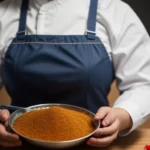A Taste of Tradition: Authentic Spanish Dishes to Try
Spain is a country rich in culture, history, and of course, delicious cuisine. From paella to churros, Spanish dishes are known around the world for their bold flavors and unique ingredients. If you’re looking to experience the authentic taste of Spain, here are 15 traditional dishes that you must try.
1. Patatas Bravas
One of the most iconic Spanish tapas, patatas bravas are fried potatoes served with a spicy tomato sauce and aioli. The crispy potatoes and tangy sauce make for the perfect combination of flavors, making this dish a must-try for potato lovers.
2. Gazpacho
A refreshing cold soup made with tomatoes, peppers, cucumbers, and onions, gazpacho is a popular dish in Spain, especially during the hot summer months. This dish is perfect for those looking for a light and healthy option.
3. Tortilla Española
Known as the Spanish omelette, tortilla Española is a simple yet delicious dish made with eggs, potatoes, and onions. This classic dish is often served as a tapa or as a light meal, making it a versatile option for any occasion.
4. Paella
Perhaps the most famous Spanish dish, paella is a flavorful rice dish that is typically made with a combination of seafood, chicken, and vegetables. The key to a good paella is the socarrat, a caramelized crust that forms on the bottom of the pan as the rice cooks.
5. Pisto
A Spanish version of ratatouille, pisto is a vegetable stew made with tomatoes, peppers, zucchini, and onions. This hearty dish is perfect for vegetarians and can be enjoyed on its own or as a side dish.
6. Pulpo a la Gallega
A Galician specialty, pulpo a la gallega is a dish made with boiled octopus, potatoes, paprika, and olive oil. The tender octopus paired with the smoky paprika makes for a mouthwatering combination that is sure to impress.

7. Churros con Chocolate
No trip to Spain would be complete without trying churros con chocolate. These deep-fried doughnuts are served with a thick, rich hot chocolate sauce for dipping. It’s the perfect sweet treat for any time of day.
8. Fabada Asturiana
A hearty bean stew from the Asturias region of Spain, fabada asturiana is made with white beans, chorizo, morcilla (blood sausage), and pork belly. This comforting dish is often served as a main course and is best enjoyed with a crusty piece of bread.
9. Gambas al Ajillo
A simple yet delicious dish, gambas al ajillo is made with shrimp cooked in olive oil, garlic, and chili flakes. The flavors of the garlic and chili infuse the shrimp, creating a dish that is both savory and spicy.
10. Crema Catalana
Similar to crème brûlée, crema catalana is a creamy custard dessert flavored with lemon zest and cinnamon. The dish is topped with a caramelized sugar crust, creating a satisfying crunch with each bite.
11. Escalivada
A traditional Catalan dish, escalivada is made with roasted eggplant, peppers, and onions that are marinated in olive oil and vinegar. This dish is typically served as a side dish or on top of toasted bread for a simple and flavorful appetizer.
12. Torta de Santiago
A popular dessert from Galicia, torta de Santiago is an almond cake flavored with lemon zest and dusted with powdered sugar. The cake is often decorated with the cross of Saint James, making it a perfect souvenir for pilgrims who have completed the Camino de Santiago.
13. Calamares a la Romana
A popular seafood dish, calamares a la romana are fried squid rings that are crispy on the outside and tender on the inside. This dish is often served with aioli or lemon wedges for dipping.
14. Salmorejo
A thicker and creamier version of gazpacho, salmorejo is a cold soup made with tomatoes, bread, garlic, and olive oil. The soup is typically topped with diced ham and hard-boiled eggs for added flavor and texture.
15. Cocido Madrileño
A traditional stew from Madrid, cocido madrileño is made with chickpeas, vegetables, chorizo, and various cuts of pork. This hearty dish is typically served in three courses, starting with the broth, followed by the vegetables and chickpeas, and ending with the meat.
In conclusion,
Spanish cuisine is a treasure trove of flavors and textures that is sure to delight any food lover. Whether you’re a fan of seafood, meat, or vegetables, there is something for everyone to enjoy in the traditional dishes of Spain. So the next time you’re looking to experience a taste of tradition, be sure to try some of these authentic Spanish dishes. ¡Buen provecho!
FAQs about “A Taste of Tradition: Authentic Spanish Dishes to Try”
- What makes “A Taste of Tradition: Authentic Spanish Dishes to Try” a standout cookbook for enthusiasts of Spanish cuisine? “A Taste of Tradition” is an exceptional cookbook that presents a curated selection of authentic Spanish dishes, providing readers with an opportunity to experience the rich culinary heritage of Spain. It offers not only recipes but also insights into the cultural significance and historical roots of each dish, making it a must-have for anyone eager to explore the diverse flavors of Spanish cooking.
- What types of authentic Spanish dishes can readers expect to find in this cookbook? This cookbook features a variety of traditional Spanish dishes spanning from the iconic paella and gazpacho to lesser-known regional specialties like pulpo a la gallega (Galician-style octopus) and salmorejo (Andalusian tomato soup). Each recipe is meticulously crafted to capture the essence of Spanish cuisine, allowing readers to recreate the flavors of Spain in their own kitchen.
- Are the recipes in “A Taste of Tradition” suitable for cooks of all skill levels? Yes, “A Taste of Tradition” caters to cooks of all skill levels, offering a mix of beginner-friendly recipes and more challenging dishes. Whether you’re new to Spanish cooking or a seasoned chef looking to expand your repertoire, you’ll find recipes that are accessible, easy to follow, and sure to impress.
- How does this cookbook celebrate the authenticity and tradition of Spanish cuisine? In addition to providing recipes, “A Taste of Tradition” pays homage to the authenticity and tradition of Spanish cuisine. Each dish is accompanied by background information, cultural anecdotes, and tips for incorporating traditional cooking techniques and ingredients, allowing readers to gain a deeper understanding of the cultural significance of Spanish gastronomy.
- Can readers expect to explore the regional diversity of Spanish cuisine through this cookbook? Absolutely! “A Taste of Tradition” celebrates the regional diversity of Spanish cuisine by highlighting dishes from different parts of Spain. From the seafood-rich offerings of the coastal regions to the hearty stews of the interior, readers will embark on a culinary journey that showcases the distinct flavors and culinary traditions of each region.
Advantages:
- Cultural immersion: The title suggests a focus on authentic Spanish dishes, providing readers with an opportunity to immerse themselves in the culinary traditions and cultural heritage of Spain.
- Gastronomic exploration: Readers can anticipate discovering a variety of traditional Spanish dishes, offering them a comprehensive overview of Spanish culinary traditions.
- Educational value: Exploring authentic Spanish dishes offers readers the opportunity to learn about the cultural significance of different dishes, as well as the ingredients, techniques, and traditions that define Spanish cooking.
- Inspiration for cooking: The title may inspire readers to try cooking authentic Spanish dishes at home, providing them with recipes, tips, and techniques to recreate the flavors of Spain in their own kitchens.
- Accessible content: By focusing on authentic Spanish dishes, the content may appeal to readers interested in exploring traditional cuisines and seeking genuine culinary experiences.
Disadvantages:
- Lack of variety: While authenticity is valued, the focus solely on traditional Spanish dishes may limit the scope of the content, potentially overlooking modern interpretations or lesser-known regional specialties.
- Cultural preservation vs. evolution: Emphasizing tradition may overlook the dynamic nature of culinary culture, which evolves over time, incorporating new influences and innovations.
- Accessibility of ingredients: Some traditional Spanish dishes may require specific ingredients that are difficult to find outside of Spain or major culinary hubs, limiting the practicality of the recipes for some readers.
- Dietary restrictions: Traditional Spanish cuisine often includes ingredients like meat, seafood, and dairy, which may not be suitable for individuals with dietary restrictions or preferences, potentially alienating some readers.
- Potential cultural appropriation: Without proper context and understanding, exploring traditional Spanish dishes could risk appropriating cultural elements without acknowledging their significance or respecting their origins.
















